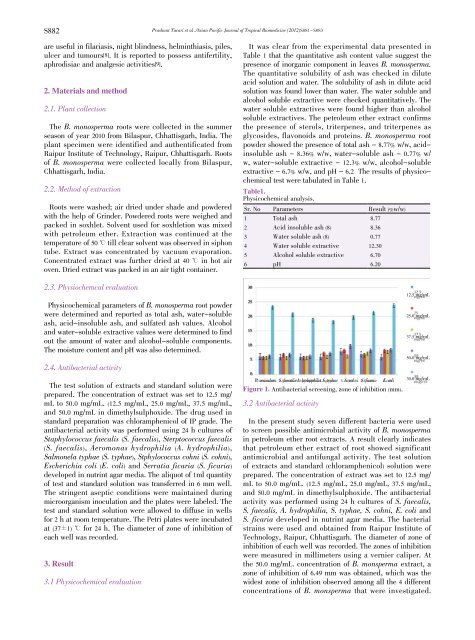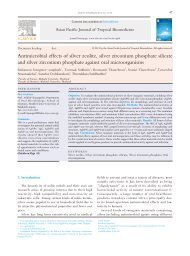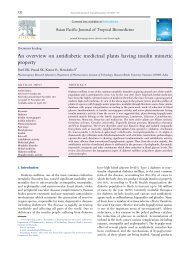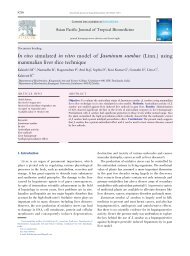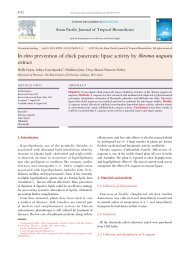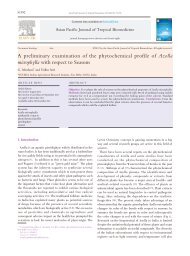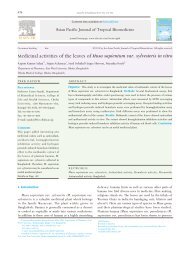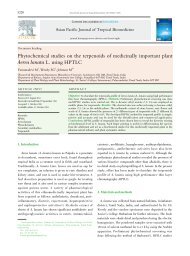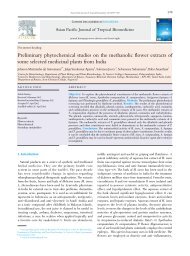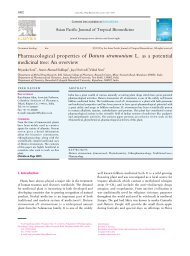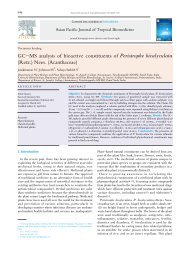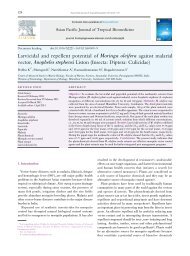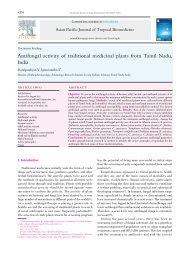Antibacterial activity and physicochemical evaluation of ... - Apjtb.com
Antibacterial activity and physicochemical evaluation of ... - Apjtb.com
Antibacterial activity and physicochemical evaluation of ... - Apjtb.com
You also want an ePaper? Increase the reach of your titles
YUMPU automatically turns print PDFs into web optimized ePapers that Google loves.
S882<br />
are useful in filariasis, night blindness, helminthiasis, piles,<br />
ulcer <strong>and</strong> tumours[8]. It is reported to possess antifertility,<br />
aphrodisiac <strong>and</strong> analgesic activities[9].<br />
2. Materials <strong>and</strong> method<br />
2.1. Plant collection<br />
The B. monosperma roots were collected in the summer<br />
season <strong>of</strong> year 2010 from Bilaspur, Chhattisgarh, India. The<br />
plant specimen were identified <strong>and</strong> authentificated from<br />
Raipur Institute <strong>of</strong> Technology, Raipur, Chhattisgarh. Roots<br />
<strong>of</strong> B. monosperma were collected locally from Bilaspur,<br />
Chhattisgarh, India.<br />
2.2. Method <strong>of</strong> extraction<br />
Roots were washed; air dried under shade <strong>and</strong> powdered<br />
with the help <strong>of</strong> Grinder. Powdered roots were weighed <strong>and</strong><br />
packed in soxhlet. Solvent used for soxhletion was mixed<br />
with petroleum ether. Extraction was continued at the<br />
temperature <strong>of</strong> 50 曟 till clear solvent was observed in siphon<br />
tube. Extract was concentrated by vacuum evaporation.<br />
Concentrated extract was further dried at 40 曟 in hot air<br />
oven. Dried extract was packed in an air tight container.<br />
2.3. Physiochemcal <strong>evaluation</strong><br />
Physicochemical parameters <strong>of</strong> B. monosperma root powder<br />
were determined <strong>and</strong> reported as total ash, water-soluble<br />
ash, acid-insoluble ash, <strong>and</strong> sulfated ash values. Alcohol<br />
<strong>and</strong> water-soluble extractive values were determined to find<br />
out the amount <strong>of</strong> water <strong>and</strong> alcohol-soluble <strong>com</strong>ponents.<br />
The moisture content <strong>and</strong> pH was also determined.<br />
2.4. <strong>Antibacterial</strong> <strong>activity</strong><br />
The test solution <strong>of</strong> extracts <strong>and</strong> st<strong>and</strong>ard solution were<br />
prepared. The concentration <strong>of</strong> extract was set to 12.5 mg/<br />
mL to 50.0 mg/mL. (12.5 mg/mL, 25.0 mg/mL, 37.5 mg/mL,<br />
<strong>and</strong> 50.0 mg/mL in dimethylsulphoxide. The drug used in<br />
st<strong>and</strong>ard preparation was chloramphenicol <strong>of</strong> IP grade. The<br />
antibacterial <strong>activity</strong> was performed using 24 h cultures <strong>of</strong><br />
Staphylococcus faecalis (S. faecalis), Sterptococcus faecalis<br />
(S. faecalis), Aeromonas hydrophilia (A. hydrophilia),<br />
Salmonela typhae (S. typhae), Stphylococcus cohni (S. cohni),<br />
Escherichia coli (E. coli) <strong>and</strong> Serratia ficaria (S. ficaria)<br />
developed in nutrint agar media. The aliquot <strong>of</strong> 1ml quantity<br />
<strong>of</strong> test <strong>and</strong> st<strong>and</strong>ard solution was transferred in 6 mm well.<br />
The stringent aseptic conditions were maintained during<br />
microorganism inoculation <strong>and</strong> the plates were labeled. The<br />
test <strong>and</strong> st<strong>and</strong>ard solution were allowed to diffuse in wells<br />
for 2 h at room temperature. The Petri plates were incubated<br />
at (37暲1) 曟 for 24 h. The diameter <strong>of</strong> zone <strong>of</strong> inhibition <strong>of</strong><br />
each well was recorded.<br />
3. Result<br />
3.1 Physicochemical <strong>evaluation</strong><br />
Prashant Tiwari et al ./Asian Pacific Journal <strong>of</strong> Tropical Biomedicine (2012)S881-S883<br />
It was clear from the experimental data presented in<br />
Table 1 that the quantitative ash content value suggest the<br />
presence <strong>of</strong> inorganic <strong>com</strong>ponent in leaves B. monosperma.<br />
The quantitative solubility <strong>of</strong> ash was checked in dilute<br />
acid solution <strong>and</strong> water. The solubility <strong>of</strong> ash in dilute acid<br />
solution was found lower than water. The water soluble <strong>and</strong><br />
alcohol soluble extractive were checked quantitatively. The<br />
water soluble extractives were found higher than alcohol<br />
soluble extractives. The petroleum ether extract confirms<br />
the presence <strong>of</strong> sterols, triterpenes, <strong>and</strong> triterpenes as<br />
glycosides, flavonoids <strong>and</strong> proteins. B. monosperma root<br />
powder showed the presence <strong>of</strong> total ash - 8.77% w/w, acidinsoluble<br />
ash - 8.36% w/w, water-soluble ash - 0.77% w/<br />
w, water-soluble extractive - 12.3% w/w, alcohol-soluble<br />
extractive - 6.7% w/w, <strong>and</strong> pH - 6.2 The results <strong>of</strong> <strong>physicochemical</strong><br />
test were tabulated in Table 1.<br />
Table1.<br />
Physicochemical analysis.<br />
Sr. No Parameters Result (%w/w)<br />
1 Total ash 8.77<br />
2 Acid insoluble ash (8) 8.36<br />
3 Water soluble ash (8) 0.77<br />
4 Water soluble extractive 12.30<br />
5 Alcohol soluble extractive 6.70<br />
6 pH 6.20<br />
30<br />
25<br />
20<br />
15<br />
10<br />
5<br />
0<br />
P. vesiculars S. faecalis A. hydrophilia S. typhae S. cohni S. ficaria E. coli<br />
Figure 1. <strong>Antibacterial</strong> screening, zone <strong>of</strong> inhibition (mm).<br />
3.2 <strong>Antibacterial</strong> <strong>activity</strong><br />
12.5 mg/mL<br />
25.0 mg/mL<br />
37.5 mg/mL<br />
50.0 mg/mL<br />
30.0 mg/mL<br />
In the present study seven different bacteria were used<br />
to screen possible antimicrobial <strong>activity</strong> <strong>of</strong> B. monosperma<br />
in petroleum ether root extracts. A result clearly indicates<br />
that petroleum ether extract <strong>of</strong> root showed significant<br />
antimicrobial <strong>and</strong> antifungal <strong>activity</strong>. The test solution<br />
<strong>of</strong> extracts <strong>and</strong> st<strong>and</strong>ard (chloramphenicol) solution were<br />
prepared. The concentration <strong>of</strong> extract was set to 12.5 mg/<br />
mL to 50.0 mg/mL. (12.5 mg/mL, 25.0 mg/mL, 37.5 mg/mL,<br />
<strong>and</strong> 50.0 mg/mL in dimethylsulphoxide. The antibacterial<br />
<strong>activity</strong> was performed using 24 h cultures <strong>of</strong> S. faecalis,<br />
S. faecalis, A. hydrophilia, S. typhae, S. cohni, E. coli <strong>and</strong><br />
S. ficaria developed in nutrint agar media. The bacterial<br />
strains were used <strong>and</strong> obtained from Raipur Institute <strong>of</strong><br />
Technology, Raipur, Chhattisgarh. The diameter <strong>of</strong> zone <strong>of</strong><br />
inhibition <strong>of</strong> each well was recorded. The zones <strong>of</strong> inhibition<br />
were measured in millimeters using a vernier caliper. At<br />
the 50.0 mg/mL. concentration <strong>of</strong> B. monsperma extract, a<br />
zone <strong>of</strong> inhibition <strong>of</strong> 6.49 mm was obtained, which was the<br />
widest zone <strong>of</strong> inhibition observed among all the 4 different<br />
concentrations <strong>of</strong> B. monsperma that were investigated.


